Previous: Degas to Picasso at the MFA (50)
Next: On Stage in Osaka and Tradition and Transformation at the MFA (15)
Laura McPhee at the MFA
Post #804 • June 6, 2006, 10:59 AM • 29 Comments
I see red flags when I see big photographs. By big, I mean big enough to mount a bathtub onto them. They've become a trendlet in contemporary art. I try to get past it, though, because I don't hold size against any other kind of work - I just have a little protective bias, formed from seeing too many big photos at art fairs that didn't justify their scale. (The photos, or the art fairs.) It will go away as I see more works that fill their wide edges with authority, and McPhee's exhibition at the MFA helped that process along.
McPhee spent two years photographing remote country in Idaho, and the exhibition, River of No Return, consists entirely of work from that series. For the most part, they deftly carry the baggage of the Hudson River School and Ansel Adams, and all the related aspirations to artistic grandeur via the Great American Landscape. The land is not unspoilt like the wilderness depicted by Thomas Cole, but it promises to maintain constant, utter indifference to human comfort, and thus its beauty has a similar edge of malevolence.
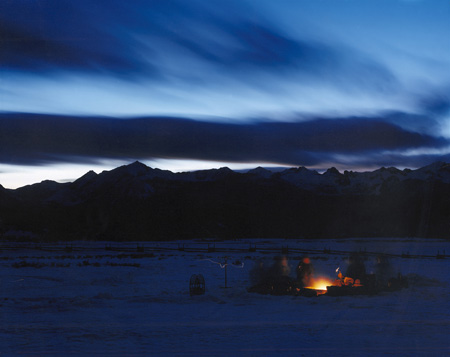
Laura McPhee, American, born in 1958: Campfire, H-Hook Ranch, Custer County, Idaho, 2004, Color photograph, Alturas Foundation, Courtesy of Bernard Toale Gallery, Boston, and Bonni Benrubi Gallery, New York. © Laura McPhee, Courtesy, Museum of Fine Arts, Boston
McPhee records explicit danger in the landscape, often to excellent dramatic effect. When these work, they convey the most originality out of the images as a whole, a striking combination of terror and loveliness.
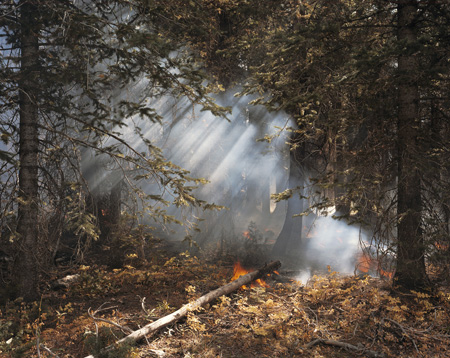
Laura McPhee: Understory Flareups, Fourth of July Creek, Valley Road Wildfire, Custer County, Idaho, 2005, Color photograph, Alturas Foundation, Courtesy of Bernard Toale Gallery, Boston, and Bonni Benrubi Gallery, New York. © Laura McPhee, Courtesy, Museum of Fine Arts, Boston
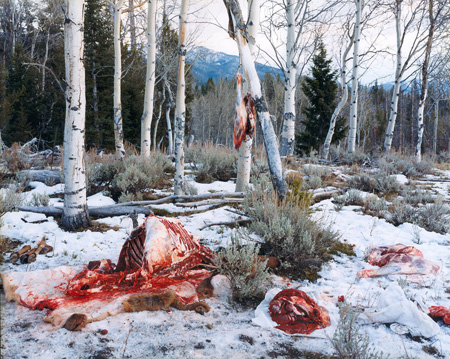
Laura McPhee: Quartered Rocky Mountain Elk, Milky Creek, White Cloud Mountains, Idaho, 2004, Color photograph, The Alturas Foundation, Courtesy of Bernard Toale Gallery, Boston and Bonni Benrubi Gallery, New York. © Laura McPhee, Courtesy, Museum of Fine Arts, Boston
The more banal interactions of man and landscape come off as environmentalist moralizing, largely because of the scale. McPhee states an intention to record dilemmas, not to offer solutions, but the weaker compositions don't elevate the dilemmas sufficiently to get larger sentiments going.
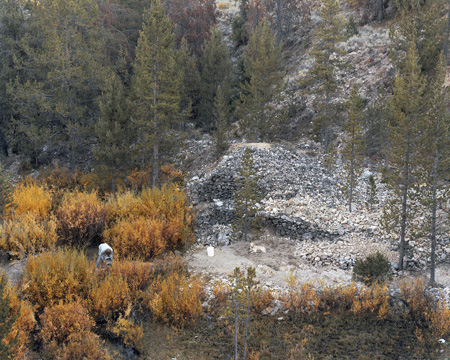
Laura McPhee: Mark Anderson Panning for Gold in 19th Century Tailings, Joe's Gulch, Lower Stanley, Idaho, 2003, Color photograph, Alturas Foundation, Courtesy of Bernard Toale Gallery, Boston, and Bonni Benrubi Gallery, New York. © Laura McPhee, Courtesy, Museum of Fine Arts, Boston
McPhee also did a portrait series of an Idahoan teenager with oversized hands and feet, like a puppy, and beautifully chiseled features. She appears posed with great meticulousness on the part of the photographer, and the series alternates between successful formal portraiture with an unusual rural angle in some shots, and self-conscious artiness in others.
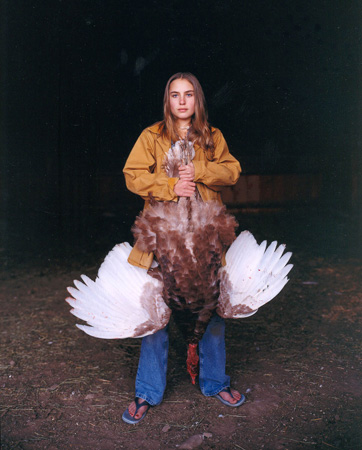
Laura McPhee: Mattie with a Bourbon Red Turkey, Laverty Ranch, Custer County, Idaho, November, 2004, 2004, Color photograph, The Alturas Foundation, Courtesy of Bernard Toale Gallery, Boston and Bonni Benrubi Gallery, New York. © Laura McPhee, Courtesy, Museum of Fine Arts, Boston
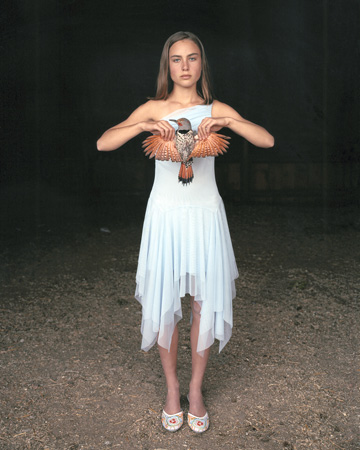
Laura McPhee: Mattie with a Northern Red-Shafted Flicker in Her Eighth Grade Graduation Dress, Laverty Ranch, Idaho, March, 2005, 2005, Color photograph, Alturas Foundation, Courtesy of Bernard Toale Gallery, Boston, and Bonni Benrubi Gallery, New York. © Laura McPhee, Courtesy, Museum of Fine Arts, Boston
The museum notes that McPhee shoots traditionally with an 8x10 view camera, hauling it and its tripod about the prairie, and that she eschews digital manipulation. That may end up mattering more to the artist than the viewer, but it reflects an obvious work ethic, and reinforces my perceptions that she scaled up these prints out of integrity, not mere ambition, and not by rote. In contrast to the way that Andreas Gursky sometimes seems to be just passing by his subject, McPhee is trying to enter it. When she succeeds, and she often does, she achieves a paradox: a large-scale act of intimacy.
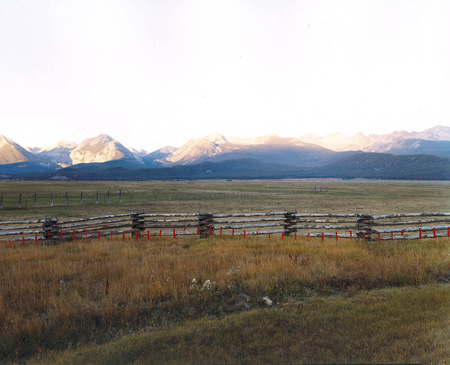
Laura McPhee: Red Fladry to Spook Wolves and Deter Them from Killing Calves, Fourth of July Creek Ranch, Custer County, Idaho, September 30, 2003, 2003, Color photograph, The Alturas Foundation, Courtesy of Bernard Toale Gallery, Boston and Bonni Benrubi Gallery, New York. © Laura McPhee, Courtesy, Museum of Fine Arts, Boston
Laura McPhee: River of No Return runs through September 17, 2006.
2.
June 6, 2006, 11:59 AM
FUNNY HOW ALL THE SUPPOSED GOOD PHOTOS NOWADAYS REEK OF FASHION PHOTOGRAPHY....I DO'T TINK THEY ACTUALLY MEAN ANYTHING...AT LEAST 50 YEARS FROM NOW, YOU KNOW?
3.
June 6, 2006, 12:08 PM
Oldpro, I admit that I braced myself for a similar response. I didn't have it, though, and here we are. It's the usual bag of gimmicks, but they're pretty good anyway.
No need to yell, Cerebus, and that's a broad statement. Gursky, since I was just mentioning him, certainly doesn't look like fashion photography. As for fifty years from now, who knows? Time is going to affect photography differently than other art because of its lack of handwriting, so to speak. It's worth thinking about.
4.
June 6, 2006, 12:21 PM
Franklin...thinking about it. But I am not speaking of what images are being made 50 years from now...I'm speaking about the images today, will they continue to excite people then? I always think that that is the true measure of "good" art. In my opinion these photos are beautiful...technically. If I walked in somewhere and these were displayed I most probably would be compelled to look. I'm just wondering if my grandchildren will.
5.
June 6, 2006, 12:26 PM
Franklin, with all possible respect, are you serious about Gursky not influencing fashion photography?
Sorry, I'm with Old Pro on this one. I swear, if you open any 'edgy' fashion mag in the UK, there are pages and pages of stuff that reference Gursky. Indeed, that's seriously one of the problems inherent in encountering the 'real' Gursky in these fallen days: everything looks like that, just smaller and cheaper and a bit low-res (so much for the debased world in which we all live), so what's the point?
Not that these things aren't pretty charismatic. It's just that I keep thinking 'I do quite like the frock ... how much is it?' (Without the dead bird, obviously ....)
6.
June 6, 2006, 12:27 PM
Oh...and yes Gursky...he is in a different league. Historically signifigant, yes! Beautiful, yes! Meaning, maybe. Theres a whole lot of our reality in these images...50 years from now, definitely! just an opinion, though.
7.
June 6, 2006, 12:28 PM
I understood it the way you meant it. You could take a pile of mediocre drawings by different artists from 50 years ago and distinguish them more easily that a pile of mediocre photographs from 50 years ago. Time will not be kind to photography. As for the McPhees, I'd tend to think that if something in them compells you to look, something in them will compell your grandchildren to look.
8.
June 6, 2006, 12:32 PM
Bunny, I was talking about Gursky not resembling fashion photography, not the other way around. I doubt that those two worlds are all that distinct from each other.
Ooh! New content chez Bunny! Heading there now...
9.
June 6, 2006, 12:36 PM
Point taken...i guess we meant the same thing...i'm just not as eloquent. thanks for the comments.
10.
June 6, 2006, 12:37 PM
I don't have a problem with scale in photography, but I know what you mean. I think large scale photography is filling a market niche for collectors which want "realistic work", it's a modern day replacement for academic realism. At the current time, Photoshop has destroyed the veracity of the photograph. McPhee stating that she eschews digital manipulation only serves to point out that the photograph may not be necessarily "recording a moment in time".
To me McPhees photographs make me think of "snapshots", while this may be a valid association it does make me agree with Franklins skepticism about the large scale.
I recently saw two shows of new photography.
Tuen Hocks at P.P.O.W Gallery and
Loretta Lux at Yosi Milo gallery.
There seems to be a trend towards making the photograph look like a painting again. Both artists manipulate the photograph or setup extensively, I assume using digital tools like Photoshop. Because of the manipulations, which are seamless and masterfully done, the photographs by Lux are somewhat creepy. Her subjects fall into a genera that's hard for the public not to like and I'd have to see more work before I am convinced. I found Hocks photographs just so, so, a bit interesting but they didn't get me past thinking about how he did them.
11.
June 6, 2006, 12:37 PM
Lordy, Frankin, just say no!
I'd go for the short-sentence ephemera, myself. Life's so much richer, that way.
Seriously, though, I am sure you are right about Gursky. I blame the offspring of my lack of interest in (a) photography and (b) fashion. Not the most promising lineage, really, is it? (Still, I do quite like the frock. But not accessorised with a flicker. That would be dreary in practice.)
12.
June 6, 2006, 12:55 PM
That would be dreary in practice.
Might violate some game laws, too.
Fashion doesn't interest me much, but fashion photography can be fun. Usually the subjects are easy on the eyes, if nothing else.
13.
June 6, 2006, 12:56 PM
I think you are right about large photographs filling the need for good old-fashioned realism, George. And you can get a photograph somewhat cheaper and not look likr you are stinting.
Loretta Lux really has something well worked out here, kind of an ultimate mannerist, almost pre-rapaelite kind of image, exquisitely done She may already be rich and famous, for all I know, but if she isn't she soon will be. Again, not for me.
The Hocks, like so much new painting, just carries me right back to 1940s latter-day surrealism.
14.
June 6, 2006, 1:11 PM
Loretta Lux: Word is they are $25k for the larger prints 20x20 inches, in editionions of 7.
15.
June 6, 2006, 1:51 PM
Usually the subjects are easy on the eyes, if nothing else.
That's part of my problem with photos like this. Shooting attractive snaps of lovely rural areas and the equally lovely inhabitants thereof ... how hard is that? I mean, one has to centre the figure, and ask her to hold still, but ... well, is that really a huge acheivement?
Also - and this is just an ill-advised (I guess) burst of honesty - but to me, there is something slightly odd about the photographer's relationship with this girl. It's a banal thing to write, and I know it, but it's almost as if she's being treated like the moribund flicker, or like the landscape. And I hated this when people did it to the men and women who lived in the dustbowl, or the South, in the 1930s, and it still annoys me a bit. Oh well, maybe Calvin Klein's various agents will 'spot' her and she'll escape the future for which she's probably otherwise headed ... but when such a huge part of the appeal of these photos is her beauty (because, let's face it, this girl would be lovely in a paper bag, let alone her prom frock) it seems a bit strange that she's so obviously the passive, voiceless, skipped-over feature here. But again, I know that's banal. Sorry. It's been a long day. I'll try harder next time.
16.
June 6, 2006, 2:12 PM
I was thinking the same thing: Honey, there's money in them there cheekbones.
To be fair, I think shots of the landscape look good by dint of craft even if you do have great material to work with.
17.
June 6, 2006, 2:19 PM
I guess my problem is, at least in part, the suspicion that this girl is all very well, as long as she's all cheekbones and no mouth. As long as she's an inscrutable noble savage, fine. But I suspect that the moment anyone asked her opinion on religion, politics, war, peace etc, we'd be on to different territory.
Perhaps the photos are supposed to interrogate me regarding this particular point, and perhaps I'm showing myself culpably impervious to some sort of irony.
Still, though - yup, very lovely cheekbones.
18.
June 6, 2006, 2:25 PM
Imperviousness to irony is a virtue, not a fault. I hope we're not looking at irony written at life size - that would be annoying as hell. I don't think we are, though.
That's quite an effort on the Bellini show, Bunny. I'm about a tenth of the way through it, but so far, beautiful work, as always.
19.
June 6, 2006, 2:35 PM
To touch gently upon a theme raised earlier in respect of these photos, big isn't always beautiful, is it?
Still, thanks for the kind words.
20.
June 6, 2006, 3:49 PM
Geez, Bunny, every time you say something interesting, original and provocative you apologize for it. I think mentioning these direct, personal observations should be done if for no other reason than no one else does it, least of all "serious critics". More, please!
I already read your Bellini piece because I have your site bookmarked and keep bringing it up in frustration, looking for something new. It was great. I wish you were out there covering the whole scene.
These photos also remind me of the "tableux vivant" that ladies used to put on back in Victorian times, living dioramas illustrating Greek mythology and such like.
I understand that there is a line of "McFee's Flickerfrocks" in the works.
21.
June 6, 2006, 4:26 PM
This stuff is all right for what it is, I suppose, but I can't get at all worked up over it--least of all the pictures using the girl, which strike me as insufferably contrived. Knowing the photographer would resort to such measures lowers my estimation of her entire output.
22.
June 6, 2006, 4:33 PM
Old Pro, thanks for the words of encouragement - even if my 'interesting' and 'original' critical voice tells me that the Bellini piece you mention could have done with a bit of editing!
(Seriously, though, it means a lot to know you liked it. And don't worry, the review of the Greenberg biography is coming, if not soon, at least within the next month or so, which by my standards probably counts as 'soon'.)
As for the Flickerfrock, I think I'd better wait until TopShop produces the cheapo knock-off of the designer original .... whilst enjoying their advertising campaigns, of course. With or without the irony.
23.
June 6, 2006, 4:46 PM
Anything can be edited, but one of the pleasures of your writing is the way you meander around and suddenly the reader finds himself manouvered into some completely new angle on the subject before he knows what has happened. I don't think you should risk losing that.
I am very pleased that you are going to review the Greenberg book. I wrote a quickie for Amazon, but that book needs a thorough going over. If you want to discuss factual & other errors via email I will be happy to do so.
24.
June 6, 2006, 7:56 PM
I wonder about the photograph. It can simultaneously feel precious, and dismissable (if not downright disposable). We can dismiss fine art photography by calling it a 'snapshot' or elevate it by calling it a 'portrait'. And there is hardly a person on this continent who is not already a sophisticated viewer of photos by the age of ten. People sure do love their straight ahead picture-perfect images these days, eh - even better when a picture is trickily manipulated, like the illusionist's act.
I think good photography is difficult for us to see, for these reasons (among others). But photography is nonetheless extremely easy to use effectively, in all manner of ways. Like the proverbial hammer from a few posts back. Works better to feel the swinging weight of it in your hand than to talk about why it looks like it might make a good one.
25.
June 6, 2006, 8:40 PM
At the risk of embarrassing her, I'll put one of my favorite quotes from a Bunny Smedley article up here. From a really thoughtful article, first of three, on the Netherlands today:
"Over the years, the Netherlands have given Britain fen drainage, refuge from Marian persecution, gin, the limited company, cheap prints, William of Orange, investment banking, the word 'landscape', the concept of secularised international law, radical protestant literature and access to hardcore pornography. I am not sure what, precisely, we have given the Dutch, although depending on social class, they seem impressed either by Jermyn Street and Savile Row, or by the technical proficiency of our football hooligans. Alternatively, in Amsterdam, at least, they dislike our loud songs, our inability to take drink, our predilection for cheap and horrible food and the randomness of our holiday urination."
Brilliant. And there's so many more just as good.
26.
June 6, 2006, 9:31 PM
Re24, Ahab,
And there is hardly a person on this continent who is not already a sophisticated viewer of photos by the age of ten.
Your observation is right on the money. Moreover, a considerable amount of advertising money is spent producing "just the right" commercial image, images designed to sell a product with the image. I think this must have a significant affect on the viewers, which as you said "are sophisticated" or at least acclimated to a photographic images. This must affect how photographs are seen, the viewer has a set of expectations they bring to the photograph. I think this is one of the questions that artists in the medium are currently trying to address. If the question "is it real or is it Photoshop" is probably less important than it once was, the issue seems to be how one uses the photograph to make a memorable image in a world already full of images.
27.
June 6, 2006, 10:58 PM
That's right, JL. She seems to be writing just for the fun of it, and damned if it isn't just as much fun to read.
28.
June 13, 2006, 1:07 PM
Where do these people get the $$$$ bank for 8x10 cams and material! They seem to be everwhere. And , here's a question, do you think digital will ever meet the high standards of sa 4x5 to 8x10
29.
June 13, 2006, 2:57 PM
If they haven't already, J.M., then it's certainly just a matter of time.
1.
oldpro
June 6, 2006, 11:33 AM
Well, I think McPhee has cleverly put together a number of current mainstream methods to make what should be successsful in the market: Large photos, odd subject matter, deadpan titles, unsmiling centrally located single figures with an aura of eeriness, a dash of PC, some dead animals and gore (has anyone noticed all the taxidermy in the galleries lately?) - she should do well. They leave me cold.
At least I learned a new word: FLADRY